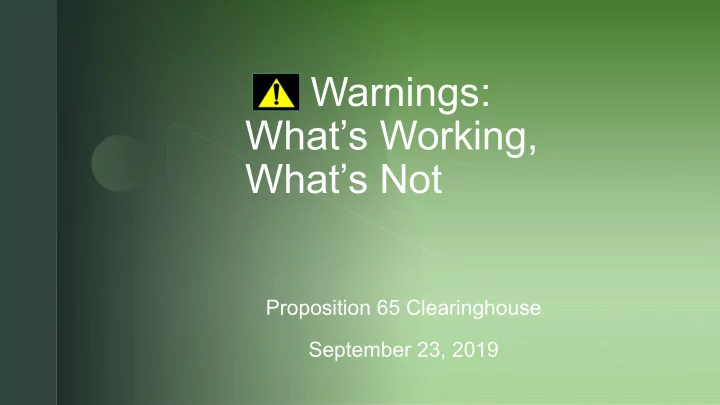

Warnings: What’s Working, What’s Not � Proposition 65 Clearinghouse September 23, 2019
2 Moderator: Carol Monahan-Cummings Chief Counsel, OEHHA Panel: Rachel Michelin � President, California Retailers Association Judith Praitis Partner, Sidley Austin David Roe Retired, Law Offices of David Roe Will Wagner 9/23/2019 P65 Clearinghouse Associate, Greenberg Traurig
� 3 9/23/2019 P65 Clearinghouse
Proposition 65 Inquiry Increase � Proposition 65 E-mail Inquiries from Businesses and Consumers 20000 18000 16000 14000 12000 10000 8000 6000 4000 2000 0 2015-2016 2016-2017 2017-2018 2018-2019 2015-2016 2016-2017 2017-2018 2018-2019 Daily phone consultation inquiries/ 10-15 10-20 15-30 10-20 requests from businesses and consumers
5 9/23/2019 P65 Clearinghouse
6 INITIAL RESPONSES BY REGULATED INDUSTRY TO NEW PROPOSITION 65 WARNING REGULATIONS CHAOS � CONFUSION CONSTERNATION 9/23/2019 P65 Clearinghouse
7 INITIAL RESPONSES BY REGULATED INDUSTRY TO NEW PROPOSITION 65 WARNING REGULATIONS MANY BELIEVED THE REGULATIONS CHANGED WHETHER TO WARN, NOT JUST HOW TO WARN. THEN, MAJOR CONFUSION PERSISTED OVER WHETHER THE “SAFE HARBOR” FORMS OF WARNING WERE MANDATORY , VOLUNTARY OR SOMETHING IN BETWEEN. 9/23/2019 P65 Clearinghouse
8 OTHER COMMON TOPICS OF CONFUSION, EVEN FOR SOPHISTICATED COMPANIES WITH COMPLIANCE RESOURCES, INCLUDED THE FOLLOWING: 1. When long-form and short form warnings could be used. 2. Disbelief that “safe harbor” terms require “duplicate warnings” for internet sales. 3. Internet warnings—who, what, when, where, why and how. 4. Retailers believed that the new warnings required them to demand identification of ALL Proposition 65 listed chemicals in every product they sold. 5. Retailers believed that only “safe harbor” warnings were legally permissible. 6. Manufacturers tried to “offload” all warning obligations downstream to “California retailers only.” 7. What do “authorized agents” do and are they mandatory? 9/23/2019 P65 Clearinghouse 8. Why does everyone in the chain of commerce still get sued no matter what contractual allocations of responsibility they agree upon?
� ADDITIONAL TOPICS OF CONCERN: Many entities do not understand that the “safe harbor” form of warning requires use of category specific warning regimes— such as for furniture—if those are provided for in regulations. There is particular confusion over warnings for foods, including dietary supplements. There is a debate within the regulated community whether truncated form warnings can be used for foods. The regulations strictly interpreted may not provide for this warning option. Informal guidance has opened the possibility.
10 � Allocation of Responsibility � 27 CCR § 25600.2 � Regulations are intended to minimize the burden on retail sellers of consumer products, except where the retail seller itself is responsible for introducing a listed chemical. � Manufacturer may comply by either (1) providing a warning on the product label or labeling that satisfies Section 25249.6 or (2) providing a downstream notice to retailer. � Proposed amendment to downstream notice regulation permits manufacturer to send notice to the authorized agent of business to which it transfers the product. � Prop 65 contractual terms may allocate legal responsibility within the supply chain.
11 � Warning Alternatives Standard safe harbor warning – identify one listed substance for each � endpoint Short form warning � � Adopted because of limited packaging size � Limits information provided to consumers � OEHHA may revisit short form warning regulation to limit application – i.e. only allow it on smaller packages � Practical drawbacks to short form warnings Occupational product warnings �
12 Pros and Cons of � Testing v. Prophylactic Warnings Compliance testing and exposure analyses can be expensive, especially � when many products at issue Variance in test results between batches/lots can further complicate testing � programs E.g., heavy metal content can vary from lot to lot in a wide array of food � products Plaintiffs can issue notices of violation if they test the “right” lot � However, potential unintended consequences if warnings are added � without testing: Impact sales (perhaps nationwide) for no reason � Concession of substances in product/false representation �
13 � Retailer Perspective � Warning “dumping” � Sticker labels just for CA markets � E-commerce vs brick and mortar issues � Does the opportunity to cure provision work? 9/23/2019 P65 Clearinghouse
14 What’s Next? More regulatory changes Short Form � Manufacturer vs Retailer Tailored warnings Internet warnings Litigation Settlements 9/23/2019 P65 Clearinghouse
Questions? � 15 9/23/2019 P65 Clearinghouse
Recommend
More recommend